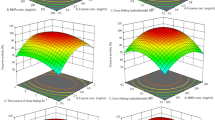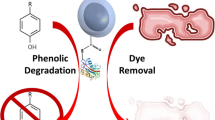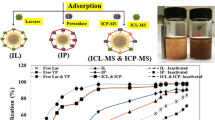Abstract
Iron oxide magnetic particles (PMag) synthesized by microwave heating and irradiation were evaluated individually and loaded with laccases produced by the white-rot fungi Trametes villosa for removal of Acid Blue 277 and Acid Black 172 dyes. PMag were tested for the adsorption capacity and laccase enzymes were successfully immobilized on the surface of PMag, previously functionalized by APTES ((3-aminopropyl) triethoxysilane) and glutaraldehyde (Lac-PMag), for simultaneous adsorption and biodegradation of the dyes. PMag removed approximately 99.00% of Acid Blue 277 and 98.00% of Acid Black 172 from aqueous solutions at an initial dye concentration of 10 mg L−1. The immobilization yield of laccase enzymes was 99.85 ± 0.18%, and recovered activity was 46.18 ± 0.20%. In the simultaneous process of adsorption and biodegradation of dyes, Lac-PMag presented two-fold the removal efficiency of PMag at the highest initial concentration of the dyes. Lac-PMag removed 52.72 ± 1.23 and 57.47 ± 2.38 mg g−1 of Acid Blue 277 and Acid Black 172, respectively, both at an initial concentration of 300 mg L−1. Hence, the synthesized PMag was more effective in removing the dyes at the lowest initial concentrations in solution and Lac-PMag demonstrated efficiency in a simultaneous process of adsorption and biodegradation in higher concentrations of the dyes. Our results highlight the synergistic effect of adsorption and enzymatic degradation on dyes removal by Lac-PMag, which makes the technology even more efficient, ecofriendly, and economical.
Highlights
• PMag functionalization and silanization process improve particles adsorption.
• Laccase activity of Lac-PMag is stored for 8 months.
• Magnetic particles are easily recovered from the solution using a magnetic field.
• The simultaneous adsorption and biodegradation improve dye removal efficiency.
Graphical abstract







Similar content being viewed by others
Data Availability
The datasets supporting the conclusions of this articleare included within the article and its additional files.
References
Akpinar, M., & Ozturk, R. (2017). Induction of fungal laccase production under solid state bioprocessing of new agroindustrial waste and its application on dye decolorization. 3 Biotech, 7(2), 1–10. https://doi.org/10.1007/s13205-017-0742-5
Albuquerque, I. L. T., Santos, P. T. A., Cornejo, D. R., Bicalho, S. M. C. M., Oliveira, L. S. C., Federal, U., et al. (2017). Modificação da superf í cie de nanocompósitos de Fe 2 O 3 / Fe 3 O 4 visando seu uso para imobilização da glicose oxidase 63 244–252.
Alexandrino, A. M., De Faria, H. G., Giatti, C., Souza, M. . De., & Peralta, R. M. (2007). Aproveitamento do resíduo de laranja para a produção de enzimas lignocelulolíticas por. Pleurotus ostreatus (Jack: Fr), 27(2), 364–368.
Antecka, K., Zdarta, J., Siwińska-Stefańska, K., Sztuk, G., Jankowska, E., Oleskowicz-Popiel, P., & Jesionowski, T. (2018). Synergistic degradation of dye wastewaters using binary or ternary oxide systems with immobilized laccase. Catalysts, 8(9). https://doi.org/10.3390/catal8090402
Baldrian, P. (2006). Fungal laccases-occurrence and properties. FEMS Microbiology Reviews, 30(2), 215–242. https://doi.org/10.1111/j.1574-4976.2005.00010.x
Beatriz, A., Capítulo, V., & Capítulo, C. T. (n.d.). Equipe de tradução.
Bruce, I. J., Taylor, J., Todd, M., Davies, M. J., Borioni, E., Sangregorio, C., & Sen, T. (2004). Synthesis, characterisation and application of silica-magnetite nanocomposites. Journal of Magnetism and Magnetic Materials, 284(1–3), 145–160. https://doi.org/10.1016/j.jmmm.2004.06.032
Cao, L. (2005). Immobilised enzymes : science or art ?, 217–226. https://doi.org/10.1016/j.cbpa.2005.02.014
Cardoso, B. K., Linde, G. A., Colauto, N. B., & do Valle, J. S. (2018). Panus strigellus laccase decolorizes anthraquinone, azo, and triphenylmethane dyes. Biocatalysis and Agricultural Biotechnology, 16, 558–563. https://doi.org/10.1016/j.bcab.2018.09.026
Chen, J., Leng, J., Yang, X., Liao, L., Liu, L., & Xiao, A. (2017). Enhanced performance of magnetic graphene oxide-immobilized laccase and its application for the decolorization of dyes. https://doi.org/10.3390/molecules22020221
Chhabra, M., Mishra, S., & Sreekrishnan, T. R. (2015). Immobilized laccase mediated dye decolorization and transformation pathway of azo dye acid red 27. Journal of Environmental Health Science and Engineering, 13(1), 1–9. https://doi.org/10.1186/s40201-015-0192-0
Chowdhury, S., Mishra, R., Saha, P., & Kushwaha, P. (2011). Adsorption thermodynamics, kinetics and isosteric heat of adsorption of malachite green onto chemically modified rice husk. Desalination, 265(1–3), 159–168. https://doi.org/10.1016/j.desal.2010.07.047
Costa, J. B., Lima, M. J., Sampaio, M. J., Neves, M. C., Faria, J. L., Morales-torres, S., et al. (2019). Enhanced biocatalytic sustainability of laccase by immobilization on functionalized carbon nanotubes / polysulfone membranes. Chemical Engineering Journal, 355, 974–985. https://doi.org/10.1016/j.cej.2018.08.178
Cui, J., Ren, S., Lin, T., Feng, Y., & Jia, S. (2018). Shielding e ff ects of Fe 3 + -tannic acid nanocoatings for immobilized enzyme on magnetic Fe 3 O 4 @ silica core shell nanosphere. Chemical Engineering Journal, 343, 629–637. https://doi.org/10.1016/j.cej.2018.03.002
Daâssi, D., Rodríguez-couto, S., Nasri, M., & Mechichi, T. (2014). International biodeterioration & biodegradation biodegradation of textile dyes by immobilized laccase from Coriolopsis gallica into Ca-alginate beads. International Biodeterioration & Biodegradation, 90, 71–78. https://doi.org/10.1016/j.ibiod.2014.02.006
Dai, J., Wang, H., Chi, H., Wang, Y., & Zhao, J. (2016). Engineering immobilization of laccase from Pleurotus ostreatus on magnetic separable SiO 2 support and excellent activity towards azo dye decolorization. Journal of Environmental Chemical, 4(2), 2585–2591. https://doi.org/10.1016/j.jece.2016.04.037
Do Nascimento, R. F., De Lima, A. C. A., Vidal, C. B., Melo, D. de Q., & Raulino, G. S. C. (2014). Livro sobre adsorção. https://doi.org/10.13140/RG.2.1.4340.1041
Em, P. D. E. P., Tecnologia, C. E., & Riedi, H. D. E. P. (2019). PURIFICAÇÃO , CARACTERIZAÇÃO E IMOBILIZAÇÃO DE LACASES DE BASIDIOMICETOS E SEU USO NA DEGRADAÇÃO SIMULTÂNEA PURIFICAÇÃO , CARACTERIZAÇÃO E IMOBILIZAÇÃO DE LACASES.
Fan, J., Chen, D., Li, N., Xu, Q., Li, H., He, J., & Lu, J. (2017). SC. ECSN, 100. https://doi.org/10.1016/j.chemosphere.2017.10.042
Fernández-Fernández, M., Sanromán, M. Á., & Moldes, D. (2013). Recent developments and applications of immobilized laccase. Biotechnology Advances, 31(8), 1808–1825. https://doi.org/10.1016/j.biotechadv.2012.02.013
Fortes, C. C. S., Daniel-da-Silva, A. L., Xavier, A. M. R. B., & Tavares, A. P. M. (2017). Optimization of enzyme immobilization on functionalized magnetic nanoparticles for laccase biocatalytic reactions. Chemical Engineering and Processing: Process Intensification, 117(March), 1–8. https://doi.org/10.1016/j.cep.2017.03.009
Glam, S. S. A., & Glam, N. S. A. (2016). Immobilization of laccase onto a porous nanocomposite : Application for textile dye degradation, 262–276. https://doi.org/10.3906/kim-1504-63
Guo, S., Huang, L., Li, W., Wang, Q., Wang, W., & Yang, Y. (2019). Willow tree-like functional groups modified magnetic nanoparticles for ultra-high capacity adsorption of dye. Journal of the Taiwan Institute of Chemical Engineers, 101, 99–104. https://doi.org/10.1016/j.jtice.2019.04.041
Hou, H., Zhou, J., Wang, J., Du, C., & Yan, B. (2004). Enhancement of laccase production by Pleurotus ostreatus and its use for the decolorization of anthraquinone dye. Process Biochemistry, 39(11), 1415–1419. https://doi.org/10.1016/S0032-9592(03)00267-X
Jiang, Y., Guo, C., Xia, H., Mahmood, I., Liu, C., & Liu, H. (2009). Enzymatic magnetic nanoparticles supported ionic liquids for lipase immobilization : Enzyme activity in catalyzing esterification. Journal of Molecular Catalysis B, 58, 103–109. https://doi.org/10.1016/j.molcatb.2008.12.001
Kashefi, S., Borghei, S. M., & Mahmoodi, N. M. (2019). Covalently immobilized laccase onto graphene oxide nanosheets: Preparation, characterization, and biodegradation of azo dyes in colored wastewater. Journal of Molecular Liquids, 276, 153–162. https://doi.org/10.1016/j.molliq.2018.11.156
Khatri, A., Peerzada, M. H., Mohsin, M., & White, M. (2015). A review on developments in dyeing cotton fabrics with reactive dyes for reducing effluent pollution. Journal of Cleaner Production, 87(1), 50–57. https://doi.org/10.1016/j.jclepro.2014.09.017
Kne, A., Staji, M., Vukojevi, J., & Milovanovi, I. (2014). I The effect of trace elements on wheat straw degradation by Trametes gibbosa nternational. Biodeterioration & Biodegradation, 96, 152–156. https://doi.org/10.1016/j.ibiod.2014.10.004
Kopp, W., Silva, F. A., Lima, L. N., Masunaga, S. H., Tardioli, P. W., Giordano, R. C., et al. (2015). Synthesis and characterization of robust magnetic carriers for bioprocess applications. Materials Science and Engineering B: Solid-State Materials for Advanced Technology, 193(C), 217–228. https://doi.org/10.1016/j.mseb.2014.12.002
Ladole, M. R., Pokale, P. B., Patil, S. S., Belokar, P. G., & Pandit, A. B. (2020). Laccase immobilized peroxidase mimicking magnetic metal organic frameworks for industrial dye degradation. Bioresource Technology, 317(August), 124035. https://doi.org/10.1016/j.biortech.2020.124035
Li, Y., Bi, H., Liang, Y., Mao, X., & Li, H. (2019). A magnetic core-shell dodecyl sulfate intercalated layered double hydroxide nanocomposite for the adsorption of cationic and anionic organic dyes. Applied Clay Science, 183(April), 105309. https://doi.org/10.1016/j.clay.2019.105309
Li, Z., Chen, Z., Zhu, Q., Song, J., Li, S., & Liu, X. (2020). Improved performance of immobilized laccase on Fe3O4@C-Cu2+ nanoparticles and its application for biodegradation of dyes. Journal of Hazardous Materials, 399(April), 123088. https://doi.org/10.1016/j.jhazmat.2020.123088
Liu, Y., Yan, M., Geng, Y., & Huang, J. (2016). Laccase immobilization on poly ( p -phenylenediamine )/ Fe 3 O 4 nanocomposite for Reactive Blue 19 dye removal. Applied Sciences. https://doi.org/10.3390/app6080232
Long, Y., Xiao, L., & Cao, Q. (2017). Co-polymerization of catechol and polyethylenimine on magnetic nanoparticles for efficient selective removal of anionic dyes from water. Powder Technology, 310, 24–34. https://doi.org/10.1016/j.powtec.2017.01.013
Mate, C. J., & Mishra, S. (2020). Synthesis of borax cross-linked Jhingan gum hydrogel for remediation of Remazol Brilliant Blue R ( RBBR ) dye from water : Adsorption isotherm, kinetic, thermodynamic and biodegradation studies. International Journal of Biological Macromolecules, 151, 677–690. https://doi.org/10.1016/j.ijbiomac.2020.02.192
Mohammadikish, M., & Jahanshiri, D. (2020). Rapid adsorption of cationic and anionic dyes from aqueous solution via metal-based coordination polymers nanoparticles. Solid State Sciences, 99, 106063. https://doi.org/10.1016/j.solidstatesciences.2019.106063
Mohammed, L., Gomaa, H. G., Ragab, D., & Zhu, J. (2017). Magnetic nanoparticles for environmental and biomedical applications: A review. Particuology, 30, 1–14. https://doi.org/10.1016/j.partic.2016.06.001
Monte Blanco, S. P. D., Scheufele, F. B., Módenes, A. N., Espinoza-Quiñones, F. R., Marin, P., Kroumov, A. D., & Borba, C. E. (2017). Kinetic, equilibrium and thermodynamic phenomenological modeling of reactive dye adsorption onto polymeric adsorbent. Chemical Engineering Journal, 307, 466–475. https://doi.org/10.1016/j.cej.2016.08.104
Moreira, M. T., Moldes-diz, Y., & Feijoo, G. (2017). Formulation of laccase nanobiocatalysts based on ionic and covalent interactions for the enhanced oxidation of phenolic compounds. Applied Sciences. https://doi.org/10.3390/app7080851
Morozova, O. V, Shumakovich, G. P., Shleev, S. V, Yaropolov, Y. I. (2007). Laccase – mediator systems and their applications : A review 43(5), 523–535. https://doi.org/10.1134/S0003683807050055
Nalbandian, L., Patrikidou, A., Hatzidaki, E., & Papandreou, C. N. (2015). Magnetic nanoparticles in medical diagnostic applications : Synthesis , characterization and proteins conjugation, (December). https://doi.org/10.2174/1573413712666151210230002
Nguyen, T. A., Fu, C., & Juang, R. (2016). Effective removal of sulfur dyes from water by biosorption and subsequent immobilized laccase degradation on crosslinked chitosan beads. Chemical Engineering Journal. https://doi.org/10.1016/j.cej.2016.06.102
Piscitelli, A., Giardina, P., Lettera, V., Pezzella, C., Sannia, G., & Faraco, V. (2011). Induction and transcriptional regulation of laccases in fungi, 104–112.
Pospiskova, K., Prochazkova, G., & Safarik, I. (2013). One-step magnetic modification of yeast cells by microwave-synthesized iron oxide microparticles. Letters in Applied Microbiology, 56(6), 456–461. https://doi.org/10.1111/lam.12069
Rong, J., Zhang, T., Qiu, F., & Zhu, Y. (2017). Preparation of efficient, stable, and reusable laccase − Cu 3 (PO 4 ) 2 hybrid microspheres based on copper foil for decoloration of Congo Red, 3. https://doi.org/10.1021/acssuschemeng.7b00820
Sahoo, J. K., Paikra, S. K., Mishra, M., & Sahoo, H. (2019). Amine functionalized magnetic iron oxide nanoparticles: Synthesis, antibacterial activity and rapid removal of Congo red dye. Journal of Molecular Liquids, 282, 428–440. https://doi.org/10.1016/j.molliq.2019.03.033
Sathishkumar, P., Kamala-kannan, S., Cho, M., Su, J., Hadibarata, T., Razman, M., & Oh, B. (2014). Enzymatic Laccase immobilization on cellulose nanofiber : The catalytic efficiency and recyclic application for simulated dye effluent treatment. Journal of Molecular Catalysis. B, Enzymatic, 100, 111–120. https://doi.org/10.1016/j.molcatb.2013.12.008
Semião, M. A., Windson, C., Haminiuk, I., & Maciel, G. M. (2020). Residual diatomaceous earth as a potential and cost e ff ective biosorbent of the azo textile dye Reactive Blue 160. Journal of Environmental Chemical Engineering, 8(1), 103617. https://doi.org/10.1016/j.jece.2019.103617
Wang, D., Lou, J., Yuan, J., Xu, J., Zhu, R., Wang, Q., & Fan, X. (2021). Laccase immobilization on core-shell magnetic metal-organic framework microspheres for alkylphenol ethoxylate compound removal. Journal of Environmental Chemical Engineering, 9(1), 105000. https://doi.org/10.1016/j.jece.2020.105000
Wang, H., Zhang, W., Zhao, J., Xu, L., Zhou, C., Chang, L., & Wang, L. (2013). Rapid decolorization of phenolic azo dyes by immobilized laccase with Fe 3 O 4 / SiO 2 Nanoparticles as Support, 2–8.
Wang, P., Ma, Q., Hu, D., & Wang, L. (2015). Removal of Reactive Blue 21 onto magnetic chitosan microparticles functionalized with polyamidoamine dendrimers. Reactive and Functional Polymers, 91–92, 43–50. https://doi.org/10.1016/j.reactfunctpolym.2015.04.007
Wang, Q., Yuan, T., Liu, S., Fu, X., Yang, G., Chen, J., et al. (2018). Synthesizing magnetic support for laccase immobilization for the purification of pre-hydrolysis liquor. BioResources, 13(1), 1885–1894. https://doi.org/10.15376/biores.13.1.1885-1894
Wong, J. K. H., Tan, H. K., Lau, S. Y., Yap, P. S., & Danquah, M. K. (2019). Potential and challenges of enzyme incorporated nanotechnology in dye wastewater treatment: A review. Journal of Environmental Chemical Engineering, 7(4), 103261. https://doi.org/10.1016/j.jece.2019.103261
Wu, E., Li, Y., Huang, Q., Yang, Z., Wei, A., & Hu, Q. (2019). Laccase immobilization on amino-functionalized magnetic metal organic framework for phenolic compound removal. Chemosphere, 233, 327–335. https://doi.org/10.1016/j.chemosphere.2019.05.150
Xu, R., Chi, C., Li, F., & Zhang, B. (2013). Immobilization of horseradish peroxidase on electrospun microfibrous membranes for biodegradation and adsorption of bisphenol A. Bioresource Technology, 149, 111–116. https://doi.org/10.1016/j.biortech.2013.09.030
Yang, H., Zhang, J., Liu, Y., Wang, L., Bai, L., Yang, L., et al. (2019). Rapid removal of anionic dye from water by poly(ionic liquid)-modified magnetic nanoparticles. Journal of Molecular Liquids, 284, 383–392. https://doi.org/10.1016/j.molliq.2019.04.029
Yaseen, D. A., & Scholz, M. (2019). Textile dye wastewater characteristics and constituents of synthetic effluents: A critical review. International Journal of Environmental Science and Technology (Vol. 16). Springer Berlin Heidelberg. https://doi.org/10.1007/s13762-018-2130-z
Zhang, D., Deng, M., Cao, H., Zhang, S., & Zhao, H. (2017). Laccase immobilized on magnetic nanoparticles by dopamine polymerization for 4-chlorophenol removal. Green Energy and Environment, 2(4), 393–400. https://doi.org/10.1016/j.gee.2017.04.001
Zhang, H., Wu, J. R., Wang, X., Li, X. S., Wu, M. X., Liang, F., & Yang, Y. W. (2019). One-pot solvothermal synthesis of carboxylatopillar[5]arene-modified Fe3O4 magnetic nanoparticles for ultrafast separation of cationic dyes. Dyes and Pigments, 162, 512–516. https://doi.org/10.1016/j.dyepig.2018.10.061
Zheng, C., Zheng, H., Wang, Y., Sun, Y., An, Y., Liu, H., & Liu, S. (2019a). Modified magnetic chitosan microparticles as novel superior adsorbents with huge “force field” for capturing food dyes. Journal of Hazardous Materials, 367(January), 492–503. https://doi.org/10.1016/j.jhazmat.2018.12.120
Zheng, F., Cui, B., Wu, X., Meng, G., Liu, H., & Si, J. (2016). Immobilization of laccase onto chitosan beads to enhance its capability to degrade synthetic dyes. International Biodeterioration & Biodegradation, 110(4), 69–78. https://doi.org/10.1016/j.ibiod.2016.03.004
Zheng, X., Zheng, H., Xiong, Z., Zhao, R., Liu, Y., Zhao, C., & Zheng, C. (2019). Novel anionic polyacrylamide-modify-chitosan magnetic composite nanoparticles with excellent adsorption capacity for cationic dyes and pH-independent adsorption capability for metal ions. Chemical Engineering Journal, 123706. https://doi.org/10.1016/j.cej.2019.123706
Zia, M., Phull, A. R., & Ali, J. S. (2016). Challenges of iron oxide nanoparticles, 49–67.
Acknowledgements
We would like to thank the Laboratório Multiusuário de Análises Químicas (LAMAQ) and Laboratório Multiusuários de Equipamentos e Análises Ambientais (LAMEAA) situated at Universidade Tecnológica Federal do Paraná (UTFPR), Campus Curitiba, Brazil; Centro de Microscopia Eletrônica (CME) situated at Universidade Federal do Paraná (UFPR), Campus Curitiba, Brazil, for provide the infrastructure.
Funding
We would like to thank Universidade Tecnológica Federal do Paraná (UTFPR), Campus Curitiba, Brazil; Coordenação de Aperfeiçoamento de Pessoal de Nível Superior (CAPES) (Process 1551249/2015–9) and Conselho Nacional de Desenvolvimento Científico e Tecnológico (CNPq) for C.W.I. Haminiuk research productivity scholarship (Grant number 304722/2019-7) for financial support.
Author information
Authors and Affiliations
Corresponding author
Ethics declarations
Conflict of Interest
The authors declare no competing interests.
Additional information
Publisher's Note
Springer Nature remains neutral with regard to jurisdictional claims in published maps and institutional affiliations.
Supplementary Information
Below is the link to the electronic supplementary material.
Rights and permissions
About this article
Cite this article
Modkovski, T.A., Maciel, G.M., Brugnari, T. et al. Simultaneous Removal of Textile Dyes by Adsorption and Biodegradation Using Trametes villosa Laccase Immobilized on Magnetic Particles. Water Air Soil Pollut 232, 512 (2021). https://doi.org/10.1007/s11270-021-05451-2
Received:
Accepted:
Published:
DOI: https://doi.org/10.1007/s11270-021-05451-2




